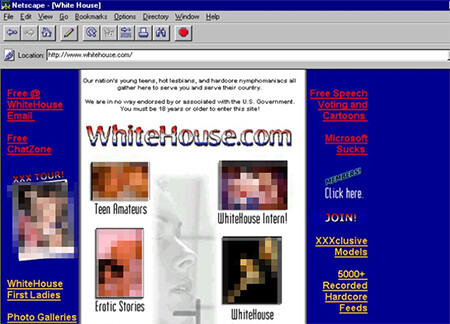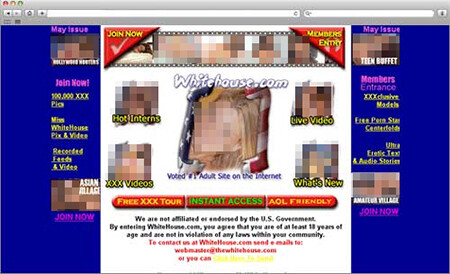A History of WhiteHouse.com, A.K.A. The Biggest Internet Controversy Of The 1990s

Many middle school students fondly remember their first visit to the White House. For some, it was an early encounter with the institutions of government, descending upon Washington D.C. in a crowded Greyhound bus for a tweenage glimpse of representative democracy. And for others, like the kids of the late 90s and early 2000s, it was the best way to trick your teacher into broadcasting softcore pornography across the computer lab.
A Cybersquatting Pioneer
Long before modems had the bandwidth to Rick Roll at high speeds, cybersquatting and typosquatting were among the preferred means of tricking someone into clicking on something they didn’t want to see. Early internet settlers gobbled up domains of trademarked brands, such as panavision.com, which misguided Hollywood types seeking info on 35mm film into viewing aerial photos of Pana, Illinois. Sites like Peta.org took things a step further, exposing People for the Ethical Treatment of Animals to People Eating Tasty Animals.

Whitehouse.gov
The Clinton Administration published the original incarnation of whitehouse.gov in 1994, and by 1995, the first imitator staked their fake claim at whitehouse.org, a satirical campaign website complete with photos of Bill Clinton negotiating with aliens, as opposed to Newts, and short biographies of political opponents branded as “losers,” “jerks,” and “weenies” in an 56k precursor to our modern discourse.
There was also whitehouse.net, another official-looking knockoff that featured an expansive collection of executive fan mail from visitors incised by pretend proposals to paint the White House green, add the Jolly Roger symbol to the American flag, and assist the Bureau of Missing Socks. (Again, this was the height of 1990s comedy.) Even users on Angelfire and Geocities got in on the action, crafting carbon-copy political parody sites for anyone savvy enough to stumble upon a 66 character URL.
Jonesing to get in on the Paula Jones jokes, a man called Dan Parisi got ahold of whitehouse.com in May 1997. The page was originally crafted as another "parody and commentary site of the White House and U.S. politics,” sticking it to the man one HTML bracket at a time. But traffic wasn’t great — and after taking note of the lucrative market for adult websites, through what must have been hours of painstaking research, Parisi decided to take things in a slightly different erection.
A Platform For Action
In August ’97, whitehouse.com was reimagined as the web’s pre-eminent destination for typographic pornography. Leaning into its below-the-Beltway identity, the refreshed site featured X-rated imagery, like a crude BDSM Photoshop of the president and first lady. We couldn’t find the actual picture from back then, but I’m sure a similar image is available on a t-shirt that your uncle owns.
In a phrase that belongs in the Pledge, the site’s masthead proclaimed that, “Our nation’s young teens, hot lesbians, and hardcore nymphomaniacs all gather here to serve you and their country.” To honor that oath, the homepage was peppered with uncensored images of nude women, AOL Friendly erotic stories, and even links to thought-provoking free speech opinion pieces like “Microsoft Sucks.”

Whitehouse.com
The timing of the relaunch was chef’s kiss perfect. Cigar smoke from President Clinton’s affair with Monica Lewinsky was just starting billow over the horizon, and the American public needed a trusted resource of XXXclusive models, hot interns, and Hollywood Hooters to serve as a guide through this turbulent time.
The smut was an overnight success. A year into the new venture, more than 7,000 subscribers were regularly forking over $20 to uncover the latest Intern of the Month, raking in more than $1 million in annual revenue. In its heyday, the site attracted 80,000 daily visitors — 13 times more people than the White House itself, where at least one guy was actually having sex instead of downloading it.
An Affair to Remember
Not everyone was enamored with tricking civic-minded researchers into visiting the Penthouse of Netscape. Almost immediately, AOL started flagging whitehouse.com emails as spam. And in December of ’97, the White House Counsel’s Office sent Mr. Parisi a strongly-worded letter in which they objected to the use of images of the White House and first family to peddle memberships to an adult video club.
But the site ultimately fell within Parisi’s First Amendment rights -- and a helpful disclaimer stating that the page wasn’t associated with the U.S. government instructed users to either beat it or get lost. If grandma’s reading glasses can’t discern com from gov, she needs a new prescription. And if “accidentally” visiting the site costs you your job, at least you’ll have a fun story for the unemployment office.

Whitehouse.com
That’s the problem with the internet: anyone can use it. That includes children, who might not be old enough to understand the intricacies of top-level domain hierarchies while hunting down photos of Socks the cat. In 2000, the Seton Hall Constitutional Law Journal laid out a hypothetical tale of a fourth grade social studies student writing a two-page paper about the U.S. government. Typing in whitehouse.com and clicking on “First Ladies,” the student would go onto encounter revealing photographs of “Miss White House,” which were completely inappropriate and wholly unacceptable — at least until January 2017.
This scenario was far from hypothetical. Redditors recall story after story of Catholic school teachers inadvertently exposing students to adult content for the first time in their lives, outside of mass. Computer labs were plastered with instructions not to visit whitehouse.com, as if spelling “boobs” on a calculator was an equivalent technological thrill. And speaking as someone who blithely got permission in class to visit the site, the thrill of briefly embarrassing public servants served as a powerful reminder that teachers don’t get paid enough for this shit.
Goodbye, White Brick House
Well into the new millennium, the site chugged along as a cautionary tale from a pre-autocorrect era. But in 2004, Parisi had a change of heart over his typosquatting endeavor and decided to clean up his code. The reason? His son was about to enter kindergarten and he worried that he’d get teased over the family business. Personally, I’d have loved the chance to meet a pornographer at career day, but to each his own.
The timing of the White House paint job was quite convenient. Representative/movie critic Mike Pence, a man weary of double-clicking a mouse over fears that it’s too suggestive, had just sponsored the Truth in Domain Names Act of 2003, which became a law that made it illegal to use deceitful URLs to trick people into viewing obscenity. And considering Parisi had already spent years cybersquatting a whole host of other domains, like madonna.com and wallstreetjournal.com, maybe it was the right time to take a break from GoDaddy.
Parisi considered selling the site altogether — not to a terrorist or another porno company, but to an interested party like whitehousefoods.com, which had presumably grown tired of emails from chagrined visitors who failed to troubleshoot pleasuring themselves to still lifes of turnips and oats. But ultimately, like a dad who could never part with his box of old Playboys in the basement, he chose to keep the domain.

Whitehouse.com
In 2005, the site shed its adults-only image and embarked on its present journey of showcasing an ever-changing grab bag of dot-com garbage. Over the years, it’s highlighted real estate listings, local town hall meetings, and resistance-era politicking, and in its present incarnation, it's both an outdated election betting site and an outdated resource for COVID-19 information.
Since whitehouse.com’s inception, it’s been called one of history’s worst websites and one of history’s most important websites. It seems to me they’re both right: building a porn business around an easy-to-make typo may not have been the most noble pursuit, but the site nevertheless taught a generation of web users (but sadly, not enough) not to take things on the Internet at face value. And even though whitehouse.com was never at the apex of web design, content, or good taste, it’s hard to see how an early dot-com cash grab could further sully the image of a building constructed by enslaved people.
Greg Ott (@_gregott) is a digital video producer at Cracked. He, like you, has a podcast.
Top image: Icsnaps/Shutterstock